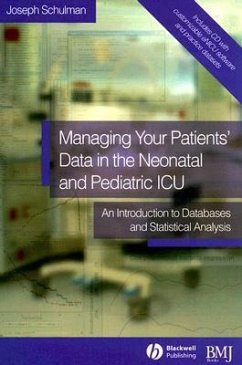Joseph Schulman (The New York Presbyterian Hospital, New York, USA)
Managing Your Patients' Data in the Neonatal and Pediatric ICU
An Introduction to Databases and Statistical Analysis
Joseph Schulman (The New York Presbyterian Hospital, New York, USA)
Managing Your Patients' Data in the Neonatal and Pediatric ICU
An Introduction to Databases and Statistical Analysis
- Broschiertes Buch
- Merkliste
- Auf die Merkliste
- Bewerten Bewerten
- Teilen
- Produkt teilen
- Produkterinnerung
- Produkterinnerung
With accompanying software! Clinicians manage a lot of data - on assorted bits of paper and in their heads. This book is about better ways to manage and understand large amounts of clinical data.
Andere Kunden interessierten sich auch für
![Atlas of Pediatric and Neonatal ICU Eeg Atlas of Pediatric and Neonatal ICU Eeg]() Atlas of Pediatric and Neonatal ICU Eeg182,99 €
Atlas of Pediatric and Neonatal ICU Eeg182,99 €![Neonatal Behavioral Assessment Scale Neonatal Behavioral Assessment Scale]() T. Berry Brazelton (USA Harvard Medical School)Neonatal Behavioral Assessment Scale69,99 €
T. Berry Brazelton (USA Harvard Medical School)Neonatal Behavioral Assessment Scale69,99 €![Essential Neonatal Medicine Essential Neonatal Medicine]() Sunil Sinha (Middlesbrough South Cleveland Hospital)Essential Neonatal Medicine66,99 €
Sunil Sinha (Middlesbrough South Cleveland Hospital)Essential Neonatal Medicine66,99 €![Neonatal Transfusion Medicine, an Issue of Clinics in Perinatology Neonatal Transfusion Medicine, an Issue of Clinics in Perinatology]() Neonatal Transfusion Medicine, an Issue of Clinics in Perinatology96,99 €
Neonatal Transfusion Medicine, an Issue of Clinics in Perinatology96,99 €![Fetal and Neonatal Lung Development Fetal and Neonatal Lung Development]() Fetal and Neonatal Lung Development175,99 €
Fetal and Neonatal Lung Development175,99 €![Oxford Textbook of the Newborn Oxford Textbook of the Newborn]() Michael Obladen (Professor of Pediatrics, Professor of Pediatrics,Oxford Textbook of the Newborn103,99 €
Michael Obladen (Professor of Pediatrics, Professor of Pediatrics,Oxford Textbook of the Newborn103,99 €![Textbook of Neonatal Ultrasound Textbook of Neonatal Ultrasound]() J. O. Haller (ed.)Textbook of Neonatal Ultrasound214,99 €
J. O. Haller (ed.)Textbook of Neonatal Ultrasound214,99 €-
-
-
With accompanying software! Clinicians manage a lot of data - on assorted bits of paper and in their heads. This book is about better ways to manage and understand large amounts of clinical data.
Produktdetails
- Produktdetails
- Verlag: John Wiley & Sons Inc
- Seitenzahl: 376
- Erscheinungstermin: 2. August 2006
- Englisch
- Abmessung: 233mm x 161mm x 19mm
- Gewicht: 736g
- ISBN-13: 9780727918703
- ISBN-10: 0727918702
- Artikelnr.: 22758683
- Herstellerkennzeichnung
- Libri GmbH
- Europaallee 1
- 36244 Bad Hersfeld
- gpsr@libri.de
- Verlag: John Wiley & Sons Inc
- Seitenzahl: 376
- Erscheinungstermin: 2. August 2006
- Englisch
- Abmessung: 233mm x 161mm x 19mm
- Gewicht: 736g
- ISBN-13: 9780727918703
- ISBN-10: 0727918702
- Artikelnr.: 22758683
- Herstellerkennzeichnung
- Libri GmbH
- Europaallee 1
- 36244 Bad Hersfeld
- gpsr@libri.de
Joseph Schulman,MD, MS Division of Newborn Medicine, Weill Medical College of Cornell University, New York-Presbyterian Hospital, New York, USA
1 Introduction.
Part I Managing data and routine reporting.
Section 1 The process of managing clinical data.
2 Paper-based patient records.
3 Computer-based patient records.
4 Aims of a patient data management process.
Section 2 Modeling data: Accurately representing our work and storing the
data so we may reliably retrieve them.
5 Data, information, and knowledge.
6 Single tables and their limitations.
7 Multiple tables: where to put the data, relationships among tables, and
creating a database.
8 Relational database management systems: normalization (Codd's rules).
Section 3 Database software.
9 From data model to database software.
10 Integrity: anticipating and preventing data accuracy problems.
11 Queries, forms, and reports.
12 Programming for greater software control.
13 Turning ideas into a useful tool: eNICU, point of care database software
for the NICU.
14 Making eNICU serve your own needs.
Section 4 Database administration.
15 Single versus multiple users.
16 Backup and recovery: assuring your data persists.
17 Security: controlling access and protecting patient confidentiality.
Conclusion - Part I: Maintaining focus on a moving target.
Part II Learning from aggregate experience: exploring and analyzing data
sets.
Section 5 Interrogating data.
18 Asking questions of a data set: crafting a conceptual framework.
and testable hypothesis.
19 Stata: a software tool to analyze data and produce graphical.
displays.
20 Preparing to analyze data.
Section 6 Analytical concepts and methods.
21 Variable types.
22 Measurement values vary: describing their distribution and summarizing
them quantitatively.
23 Data from all versus some: populations and samples.
24 Estimating population parameters: confidence intervals.
25 Comparing two sample means and testing a hypothesis.
26 Type I and type II error in a hypothesis test, power, and sample size.
27 Comparing proportions: introduction to rates and odds.
28 Stratifying the analysis of dichotomous outcomes: confounders and effect
modifiers; the Mantel-Haenszel method.
29 Ways to measure and compare the frequency of outcomes, and
standardization to compare rates.
30 Comparing the means of more than two samples.
31 Assuming little about the data: nonparametric methods of hypothesis
testing.
32 Correlation: measuring the relationship between two continuous
variables.
33 Predicting continuous outcomes: univariate and multivariate linear
regression.
34 Predicting dichotomous outcomes: logistic regression, and receiver
operating characteristic.
35 Predicting outcomes over time: survival analysis.
36 Choosing variables and hypotheses: practical considerations.
Conclusion The challenge of transforming data and information to shared
knowledge: tools that make us smart.
References.
Index.
CD ROM: eNICU files; practice data sets back cover.
"Microsoft, Access, SQL Server, andWindows are either registered trademarks
or trademarks of Microsoft Corporation in the United States and/or other
countries."
Part I Managing data and routine reporting.
Section 1 The process of managing clinical data.
2 Paper-based patient records.
3 Computer-based patient records.
4 Aims of a patient data management process.
Section 2 Modeling data: Accurately representing our work and storing the
data so we may reliably retrieve them.
5 Data, information, and knowledge.
6 Single tables and their limitations.
7 Multiple tables: where to put the data, relationships among tables, and
creating a database.
8 Relational database management systems: normalization (Codd's rules).
Section 3 Database software.
9 From data model to database software.
10 Integrity: anticipating and preventing data accuracy problems.
11 Queries, forms, and reports.
12 Programming for greater software control.
13 Turning ideas into a useful tool: eNICU, point of care database software
for the NICU.
14 Making eNICU serve your own needs.
Section 4 Database administration.
15 Single versus multiple users.
16 Backup and recovery: assuring your data persists.
17 Security: controlling access and protecting patient confidentiality.
Conclusion - Part I: Maintaining focus on a moving target.
Part II Learning from aggregate experience: exploring and analyzing data
sets.
Section 5 Interrogating data.
18 Asking questions of a data set: crafting a conceptual framework.
and testable hypothesis.
19 Stata: a software tool to analyze data and produce graphical.
displays.
20 Preparing to analyze data.
Section 6 Analytical concepts and methods.
21 Variable types.
22 Measurement values vary: describing their distribution and summarizing
them quantitatively.
23 Data from all versus some: populations and samples.
24 Estimating population parameters: confidence intervals.
25 Comparing two sample means and testing a hypothesis.
26 Type I and type II error in a hypothesis test, power, and sample size.
27 Comparing proportions: introduction to rates and odds.
28 Stratifying the analysis of dichotomous outcomes: confounders and effect
modifiers; the Mantel-Haenszel method.
29 Ways to measure and compare the frequency of outcomes, and
standardization to compare rates.
30 Comparing the means of more than two samples.
31 Assuming little about the data: nonparametric methods of hypothesis
testing.
32 Correlation: measuring the relationship between two continuous
variables.
33 Predicting continuous outcomes: univariate and multivariate linear
regression.
34 Predicting dichotomous outcomes: logistic regression, and receiver
operating characteristic.
35 Predicting outcomes over time: survival analysis.
36 Choosing variables and hypotheses: practical considerations.
Conclusion The challenge of transforming data and information to shared
knowledge: tools that make us smart.
References.
Index.
CD ROM: eNICU files; practice data sets back cover.
"Microsoft, Access, SQL Server, andWindows are either registered trademarks
or trademarks of Microsoft Corporation in the United States and/or other
countries."
1 Introduction.
Part I Managing data and routine reporting.
Section 1 The process of managing clinical data.
2 Paper-based patient records.
3 Computer-based patient records.
4 Aims of a patient data management process.
Section 2 Modeling data: Accurately representing our work and storing the
data so we may reliably retrieve them.
5 Data, information, and knowledge.
6 Single tables and their limitations.
7 Multiple tables: where to put the data, relationships among tables, and
creating a database.
8 Relational database management systems: normalization (Codd's rules).
Section 3 Database software.
9 From data model to database software.
10 Integrity: anticipating and preventing data accuracy problems.
11 Queries, forms, and reports.
12 Programming for greater software control.
13 Turning ideas into a useful tool: eNICU, point of care database software
for the NICU.
14 Making eNICU serve your own needs.
Section 4 Database administration.
15 Single versus multiple users.
16 Backup and recovery: assuring your data persists.
17 Security: controlling access and protecting patient confidentiality.
Conclusion - Part I: Maintaining focus on a moving target.
Part II Learning from aggregate experience: exploring and analyzing data
sets.
Section 5 Interrogating data.
18 Asking questions of a data set: crafting a conceptual framework.
and testable hypothesis.
19 Stata: a software tool to analyze data and produce graphical.
displays.
20 Preparing to analyze data.
Section 6 Analytical concepts and methods.
21 Variable types.
22 Measurement values vary: describing their distribution and summarizing
them quantitatively.
23 Data from all versus some: populations and samples.
24 Estimating population parameters: confidence intervals.
25 Comparing two sample means and testing a hypothesis.
26 Type I and type II error in a hypothesis test, power, and sample size.
27 Comparing proportions: introduction to rates and odds.
28 Stratifying the analysis of dichotomous outcomes: confounders and effect
modifiers; the Mantel-Haenszel method.
29 Ways to measure and compare the frequency of outcomes, and
standardization to compare rates.
30 Comparing the means of more than two samples.
31 Assuming little about the data: nonparametric methods of hypothesis
testing.
32 Correlation: measuring the relationship between two continuous
variables.
33 Predicting continuous outcomes: univariate and multivariate linear
regression.
34 Predicting dichotomous outcomes: logistic regression, and receiver
operating characteristic.
35 Predicting outcomes over time: survival analysis.
36 Choosing variables and hypotheses: practical considerations.
Conclusion The challenge of transforming data and information to shared
knowledge: tools that make us smart.
References.
Index.
CD ROM: eNICU files; practice data sets back cover.
"Microsoft, Access, SQL Server, andWindows are either registered trademarks
or trademarks of Microsoft Corporation in the United States and/or other
countries."
Part I Managing data and routine reporting.
Section 1 The process of managing clinical data.
2 Paper-based patient records.
3 Computer-based patient records.
4 Aims of a patient data management process.
Section 2 Modeling data: Accurately representing our work and storing the
data so we may reliably retrieve them.
5 Data, information, and knowledge.
6 Single tables and their limitations.
7 Multiple tables: where to put the data, relationships among tables, and
creating a database.
8 Relational database management systems: normalization (Codd's rules).
Section 3 Database software.
9 From data model to database software.
10 Integrity: anticipating and preventing data accuracy problems.
11 Queries, forms, and reports.
12 Programming for greater software control.
13 Turning ideas into a useful tool: eNICU, point of care database software
for the NICU.
14 Making eNICU serve your own needs.
Section 4 Database administration.
15 Single versus multiple users.
16 Backup and recovery: assuring your data persists.
17 Security: controlling access and protecting patient confidentiality.
Conclusion - Part I: Maintaining focus on a moving target.
Part II Learning from aggregate experience: exploring and analyzing data
sets.
Section 5 Interrogating data.
18 Asking questions of a data set: crafting a conceptual framework.
and testable hypothesis.
19 Stata: a software tool to analyze data and produce graphical.
displays.
20 Preparing to analyze data.
Section 6 Analytical concepts and methods.
21 Variable types.
22 Measurement values vary: describing their distribution and summarizing
them quantitatively.
23 Data from all versus some: populations and samples.
24 Estimating population parameters: confidence intervals.
25 Comparing two sample means and testing a hypothesis.
26 Type I and type II error in a hypothesis test, power, and sample size.
27 Comparing proportions: introduction to rates and odds.
28 Stratifying the analysis of dichotomous outcomes: confounders and effect
modifiers; the Mantel-Haenszel method.
29 Ways to measure and compare the frequency of outcomes, and
standardization to compare rates.
30 Comparing the means of more than two samples.
31 Assuming little about the data: nonparametric methods of hypothesis
testing.
32 Correlation: measuring the relationship between two continuous
variables.
33 Predicting continuous outcomes: univariate and multivariate linear
regression.
34 Predicting dichotomous outcomes: logistic regression, and receiver
operating characteristic.
35 Predicting outcomes over time: survival analysis.
36 Choosing variables and hypotheses: practical considerations.
Conclusion The challenge of transforming data and information to shared
knowledge: tools that make us smart.
References.
Index.
CD ROM: eNICU files; practice data sets back cover.
"Microsoft, Access, SQL Server, andWindows are either registered trademarks
or trademarks of Microsoft Corporation in the United States and/or other
countries."








